The purpose of pranayama is to purify the nervous system . It is as easy to do it useful. Increase its duration gradually after attaining the concentration of mind.
Technique
Sit in any comfortable posture: padmasana sidhasana or sukhasana. Make your breathing normal. Close your right nostril. When the breath has been filled in the berth through the left nostril with your third finger and stay in this state of Antrik Kumbhaka1 for a few seconds. Then lift the thumb from the right nostril and exhale slowly, keeping the nostril closed.
Repeat the process by inhaling through the left nostril and exhaling through the right nostril. This will complete one round of Nadi Shodhana Pranayama.
What needs to be emphasized in this process in the necessity of maintaining a ratio of rhythm in inhaling and exhaling. When you exhale after doing Antrik Kumdhaka (holding the breath in), your breath should not come out all at once in an uncontrolled way. Instead, it should be so regulated that it comes out very slowly and remains under your full control during this process. Hold your breath as long as you can conveniently do so; and when you release it, do very slowly.
When you have enough practice of this process, set your breathing in a regular way. Suppose, you take 4 seconds inhaling, then retain it inside for 8 seconds and release it also 8 seconds. That is, the ratio of the three processes should be 1 :2 :2 . After enough practice, change this ratio to 1:4: 2: It means that if you now take 5 seconds in inhaling, then retain it for 20 seconds and release it in 10 seconds. You need not apply force for retaining your breath; it should be done in a natural way. There should be proper ratio between the Poorak Kumbhaka and Rechaka kumbhaka. While doing Rechaka, the breath should come out in such a slow measure that it is not felt at a distance of about 3 inches from the nose. Similarly in Poooraka, the inhaling should be so slow as if only air around a distance of about 3 inches is affected.
Pooraka and Rechaka are technical terms used in Pranayama. In yoga, taking in and taking out breath is called shwasa and Prashwasa. Pooraka and Rechaka are not simple shwasa and Prashwasa but something more. In Pooraka the lungs are filled with air in measured and rhythmic way in very slow process. similarly in Rechaka lungs are emptied of air in a regular, rhythmic and measured way.
When we hold our breath in Antrik Kumbhaka, we expand our lungs and fill pure air in them. The pure air is there fore able to reach and every cell. The cells of the lungs get purified and strengthened in this way. When we do Bahya Kumbhaka, on the other hand, we retain the breath out. The cells of the lungs therefore contract and the impure air is squeezed out of them. This dual process makes the entire body clean, pure and light. This also increases longevity.
In simple breathing, we generally take the air in and then exhale it immediately thereafter. The pure air is therefore not fully utilized in the body. But kumbhaka is the unique process which brings about its full utilization in the body. The importance of Kumbhaka words. It is common knowledge that when we want to do some work with all our force, such as lifting a heavy load-discus throw, etc., we usually hold our breath. It is therefore obvious that we can increase the strength and capacity of our body by Kumbhaka.
In fact , kumbhaka is not difficult to perform because it only requires one to hold ones breath. But this does not mean that we should start doing it in an abnormal way. This can be risky or even dangerous. increasing the period of kumbhaka abruptly without sufficient prior exercise or doing it in an irregular and casual way can do more harm than good. It is very essential that we should progress gradually and increase its practice by slow measures, so that we do not come to harm.
Nadi shodhana pranayama is excellent pranayama. It is very beneficial in the ailments of the nervous system, lungs and hypertension. In this pranayama the center of concentration should be anahant chakra(see next chapter for the description of chakras).
Caution: those suffering from high and low pressure should not do Khambhaka in this pranayama, they can however practice pooraka and Rechaka slowly.
Khumbhaka should be done only after the disease has completely cured, and then is small measure.

